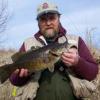To use your example, on a small river, 18” smallmouth are old bass. They are near the end of their life cycle and often don’t even spawn. That’s why very large bass over 18” are so rare in smaller rivers, assuming they aren’t harvested, they don’t live long enough to get much bigger. At a fish hatchery near where I used to live, they removed the largest smallmouth (18-21 inch fish) and released them in a local small river because they no longer were reproducing. Instead of allowing them to die of old age in a tank, they gave anglers a chance to catch and harvest them if they wanted. If someone only kept the biggest fish out of your river, there would still be the smaller fish that would continue to spawn and the population would not negatively affect the population. True, there wouldn’t be as many large bass for you to enjoy, but those fish weren’t going to survive for a long time anyway.
There is no simple answer to cover every body of water. There are many things to consider. Science aside, the DNR has to keep the people who buy licenses happy. If regulations are too strict, and don’t allow harvest, many won’t buy a license. With no restrictions on harvest, the fisheries can get destroyed.





